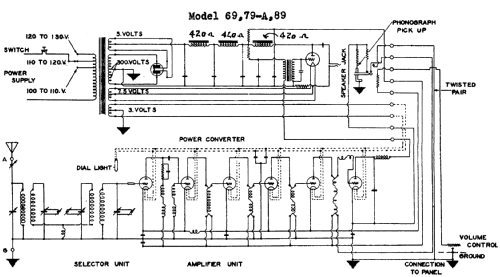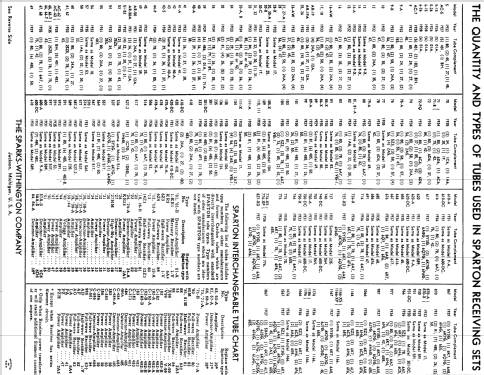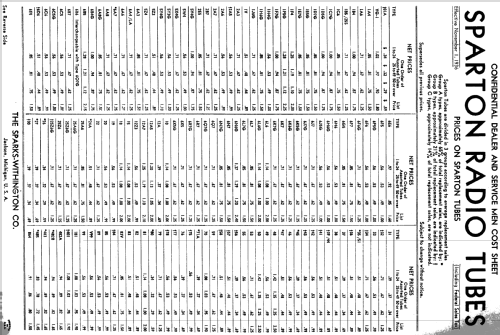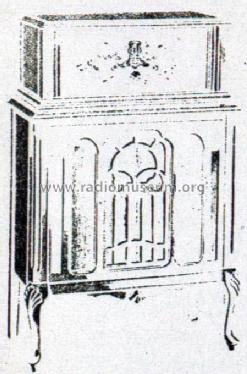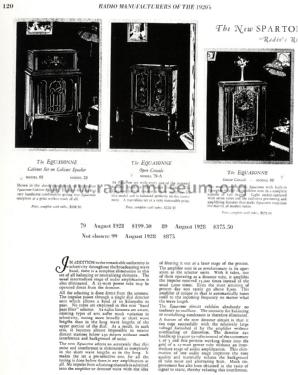Sparton 69 Equasonne on Cabinet Speaker 29
Sparks-Withington Co., (Sparton); Jackson, Michigan
- Land
- USA
- Hersteller / Marke
- Sparks-Withington Co., (Sparton); Jackson, Michigan
- Jahr
- 1928/1929

- Kategorie
- Rundfunkempfänger (Radio - oder Tuner nach WW2)
- Radiomuseum.org ID
- 226694
Klicken Sie auf den Schaltplanausschnitt, um diesen kostenlos als Dokument anzufordern.
- Anzahl Röhren
- 8
- Hauptprinzip
- Geradeaus ohne Rückkopplung
- Anzahl Kreise
- 4 Kreis(e) AM
- Wellenbereiche
- Mittelwelle, keine anderen.
- Betriebsart / Volt
- Wechselstromspeisung / 3 taps, 100 to 110, 110 to 120 and 120 to 130 Volt
- Lautsprecher
- Magnetischer Lautsprecher allgemein, System nicht definiert
- Material
- Gerät mit Holzgehäuse
- von Radiomuseum.org
- Modell: Sparton 69 Equasonne on Cabinet Speaker 29 - Sparks-Withington Co., Sparton
- Form
- Standgerät auf niedrigen Beinen (Beine < 50 % der Gesamthöhe).
- Bemerkung
-
Combination of model 69 plus Cabinet Speaker 29
The Sparton 69 and 69-A Equasonne models have one dial (primary tuning control knob). These models share the same schematic: 69, 79-A and 89 without naming the tubes and we think that 69-A is existing too because it is named below (in Radio Retailing). The list "Quantity and Types of tubes" from Sparks-Withington name for the 69: 6 x 485 Sparton, 50 and 80. See also the Sparton 69 Equasonne Cabinet Set and the model 69.
The models 39, 69, 79-A, 89, 89-A, 99, 109 and 930 are the first "Equasonne" models. The tubes are the original line up, not replacement, according to the page "The quantity and types of tubes used in Sparton receiving sets" and of Rider's page Sparton 5-6, replacement for the C-485, C-484 or 484 would be the 485_Sparton. See also the article here about different radio seasons.In "Radio Retailing" May 1933, page 47, "Tricks of the Trade" we can read for models Sparton 69-A, 79-A, 930AC, 931AC, 931DC, 301DC and 301AC: "Fourth section of band-pass selector, just preceding RF sometimes cannot be tuned to resonance with first three sections, producing weak reception and loss in selectivity. Give first, second and third selector trimmers 3 turns clockwise. This makes slightly less tuning capacity necessary for given frequency and fourth section selector can not be adjusted for resonance. Balance set in customary manner with oscillator and output meter and re-adjust kilocycle scale on dial by loosening it on shaft and re-setting."
- Originalpreis
- 199.50 $
- Literaturnachweis
- Rider's Perpetual, Volume 1 = 1931/1934 (1919 to 1931) (Rider's Sparton 1-7)
- Literatur/Schema (1)
- Radio Manufacturers of the 1920's, Vol. 3 (page 120)
- Autor
- Modellseite von Ernst Erb angelegt. Siehe bei "Änderungsvorschlag" für weitere Mitarbeit.
- Weitere Modelle
-
Hier finden Sie 827 Modelle, davon 373 mit Bildern und 773 mit Schaltbildern.
Alle gelisteten Radios usw. von Sparks-Withington Co., (Sparton); Jackson, Michigan
